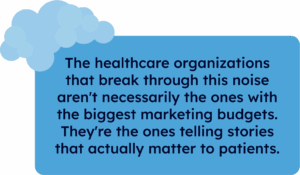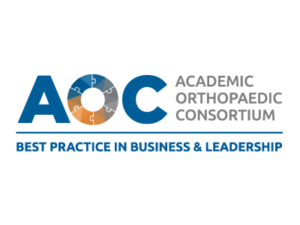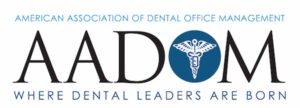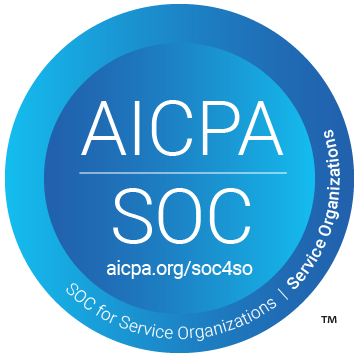Walk into any healthcare marketing meeting and you’ll probably hear the same conversation happening across the country. Someone pulls up a competitor’s website, and the room collectively sighs. “They’re saying exactly what we’re saying.”
Quality care. Compassionate staff. State-of-the-art facilities.
It’s like every healthcare organization attended the same marketing workshop and came away with the same playbook. Most of these claims are likely true. Healthcare providers generally do offer quality care and employ compassionate staff. The problem isn’t that these messages are false—it’s that they’ve become meaningless through repetition.
So, how do you stand out when everyone is essentially saying the same thing?
The Commodity Trap
Healthcare marketing has fallen into what could be called the “commodity trap.” When every organization makes identical claims, patients start viewing healthcare providers as interchangeable commodities. At that point, decisions are made based on convenience factors like location, insurance acceptance, or appointment availability rather than the actual value you provide.
Think about it from a patient’s perspective. They’re researching orthopedic surgeons online and every practice promises “personalized care” and “advanced treatment options.” How are they supposed to choose? They can’t. So they default to whichever healthcare organization has the best Google reviews or the most convenient parking.
This isn’t just frustrating for marketing teams—it’s a missed opportunity. Your organization likely has genuine strengths and unique approaches that could genuinely help patients make better decisions. If you’re not communicating them effectively, they might as well not exist.
The Stories That Actually Matter
 The healthcare organizations that break through this noise aren’t necessarily the ones with the biggest marketing budgets. They’re the ones telling stories that actually matter to patients.
The healthcare organizations that break through this noise aren’t necessarily the ones with the biggest marketing budgets. They’re the ones telling stories that actually matter to patients.
Consider a primary care practice that moved beyond generic “comprehensive care” messaging to focus on something specific: helping busy professionals manage their health without disrupting their work schedules. They offer early morning appointments, virtual visits for routine issues, and a text-based communication system for quick questions.
Is this revolutionary? Not really. It’s specific, and it speaks directly to a problem their ideal patients have. When a working parent sees that messaging, they don’t just think “Oh, another doctor’s office.” They think, “Finally, someone who gets it.”
Getting Specific About Your Value
The path out of generic messaging starts with brutal honesty about what makes your organization genuinely different. It doesn’t have to be revolutionary, it just has to be real and specific.
Maybe your specialty clinic has developed a particularly effective approach to pain management that focuses on non-opioid treatments. Perhaps your hospital has nurse practitioners who specialize in helping elderly patients navigate complex medication regimens. Or maybe your urgent care has figured out how to consistently see patients in under 15 minutes.
These aren’t earth-shattering innovations, but they’re specific value propositions that actual patients would care about. The key is identifying what you do differently and articulating it in terms that matter to the individuals you’re trying to reach.
Understanding Your Actual Patients
This is where most healthcare marketing falls short. Organizations make assumptions about what patients value without actually asking them. They assume everyone wants the same things (shorter wait times, friendlier staff, better facilities) when in reality, patient priorities vary dramatically.
The parents of pediatric patients might prioritize providers who are patient with anxious children. Seniors might value thorough explanations and unhurried appointments. Athletes might want providers who understand their goals and can help them return to activity safely.
You can’t create differentiated messaging if you don’t understand what different patient segments truly value. This requires genuine research, not just assumptions. Patient surveys, focus groups, and even informal conversations can reveal insights that completely change how you talk about your services.
Consider making patient feedback collection more systematic. Instead of relying on occasional surveys or anecdotal feedback, leverage systematic survey software that can continuously gather insights about what patients experience and what they truly value.
Once you understand what different patient segments care about, you can get proactive about reaching them with targeted messaging that actually resonates. Rather than waiting for patients to find you through generic search results, predictive analytics allow you to identify and reach out to people who are most likely to benefit from your specific services, with messages that speak directly to their priorities.
The Authenticity Test
Here’s a simple test for your marketing messages: Could a competitor say the exact same thing about their organization and have it be equally true?
If the answer is yes, you’re probably being too generic.
 “We provide compassionate, high-quality care.” Could your competitor say this? Probably.
“We provide compassionate, high-quality care.” Could your competitor say this? Probably.
“We specialize in helping athletes return to their sport safely after ACL injuries, with a track record of 95% successful returns to pre-injury performance levels.” Could your competitor say this? Probably not, assuming it’s actually true.
The more specific and measurable your claims, the harder they are for competitors to copy. The more meaningful they become to patients who are looking for exactly what you provide.
The Long Game
Building differentiated healthcare marketing isn’t a quick fix. It requires ongoing commitment to understanding your patients, measuring what matters to them, and consistently communicating your unique value.
What’s encouraging is that while most of your competitors are still stuck in the generic messaging trap, you have an opportunity to stand out simply by being more specific and authentic about what you do well.
The healthcare organizations that will thrive in the coming years aren’t necessarily those with the most resources; they’re the ones that best understand their patients.
Getting Started
If you’re ready to move beyond generic messaging, start with these questions:
Which specific problems do we solve for our patients that others don’t? What do our best patients consistently tell us they value most about our care? What would happen if we stopped trying to appeal to everyone and focused on the people we serve best?
The answers might surprise you. They’ll definitely give you something more interesting to talk about than “quality care” and “compassionate service.”
Patients don’t choose healthcare providers based on generic promises. They choose based on whether they believe you understand their specific needs and can address them effectively.
That’s where real differentiation happens. Not in the marketing department, but in the genuine understanding of what makes your organization valuable to the people who need you most.











